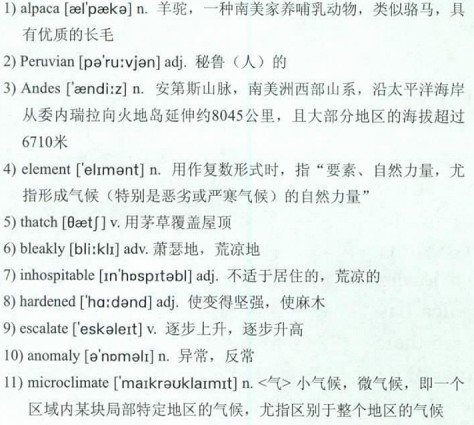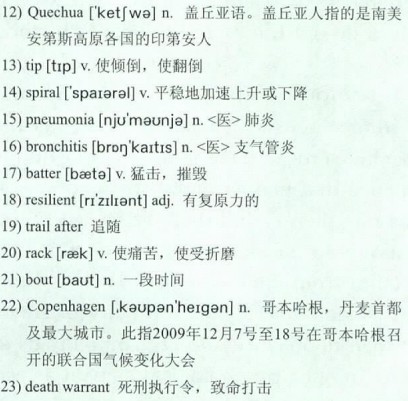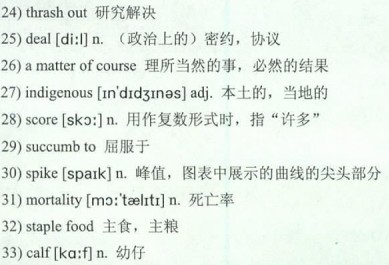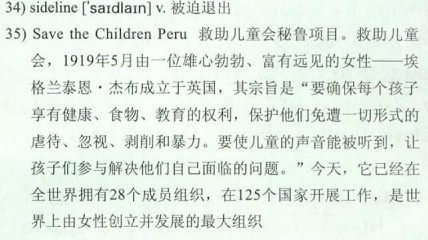文字难度:★★★
For 1)alpaca farmer Ignacio Huamani and his young family, life in the 2)Peruvian3)Andes, at almost 4,700 m above sea level, has always been a struggle against the 4)elements. His village of Pichccahuasi, in Peru’s Huancavelica region, is little more than a collection of small 5)thatched shelters and herds of alpaca surrounded by beautiful yet 6)bleakly 7)inhospitable mountain terrain. The few hundred people who live here are 8)hardened to poverty and months of sub-zero temperatures during the long winter. But, for the fourth year running, the cold came early. First their animals and now their children are dying and in such 9)escalating numbers that many fear life in the village may be rapidly approaching an end. 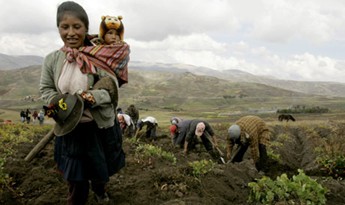 对羊驼农民伊格纳西奥·万曼尼以及他刚组建不久的家庭而言,生活在海拔4700米以上的秘鲁安第斯山区,就意味着一直要与环境气候抗争。他所居住的彼兹卡万斯村庄,位于秘鲁万卡维利卡地区,而这所谓村庄也只是有一些小茅屋和羊驼群,周围的高山地貌虽美,却荒凉而不宜居住。居住在那里的数百人已经对漫长冬天带来的贫困以及零下温度习以为常。但是,连续四年,寒冷的天气都提早到来。先是动物熬不住,现在连他们的孩子也面临着死亡的威胁。面对逐步上升的死亡数字,许多人担心村庄的生活将迅速走向尽头。
对羊驼农民伊格纳西奥·万曼尼以及他刚组建不久的家庭而言,生活在海拔4700米以上的秘鲁安第斯山区,就意味着一直要与环境气候抗争。他所居住的彼兹卡万斯村庄,位于秘鲁万卡维利卡地区,而这所谓村庄也只是有一些小茅屋和羊驼群,周围的高山地貌虽美,却荒凉而不宜居住。居住在那里的数百人已经对漫长冬天带来的贫困以及零下温度习以为常。但是,连续四年,寒冷的天气都提早到来。先是动物熬不住,现在连他们的孩子也面临着死亡的威胁。面对逐步上升的死亡数字,许多人担心村庄的生活将迅速走向尽头。
In a world growing ever hotter, Huancavelica is an 10)anomaly. These communities living at the edge of what is possible face extinction because of increasingly cold conditions in their own 11)microclimate, which may have been altered by the rapid melting of the glaciers. A consequence is that 12)Quechua-speaking farmers and their families, who have managed to subsist for centuries at high altitude, believe they may not make it through the next winter.
世界正变得越来越热,而万卡维利卡却反常地变得越来越冷。冰川的快速融化很有可能改变了万卡维利卡地区的微气候,导致天气不断变冷,这些地区的人和动物被步步进逼至极限,濒临“灭绝”的危机。后果是,尽管这些说盖丘亚语的农民及其家人千百年来在高海拔地区都能生存下来,而如今他们却认为自己可能熬不过下一个冬天。
The cold is 13)tipping Pichccahuasi into a14)spiralling decline brought on by 15)pneumonia, 16)bronchitis and hunger. Although designed to withstand the cold, Huamani’s house is crumbling and his roof, half-collapsed from the snowstorms that 17)battered the village last June and July, offers scant protection from the freezing wind and rain. His family, including four young children, sleep on wet ground night after night. His children have not yet recovered from illnesses begotten of this year’s winter and he is terrified that they won’t be 18)resilient enough to endure further freezing weather. He points to his youngest son, aged two, who 19)trails after him, soaking wet and 20)racked with 21)bouts of coughing, as he goes about his work. “All the children here are sick, they all have breathing problems,” he says. “The problem is there is too much cold, too much rain. We have had no time to recover from last winter before it has begun again. There is nothing I can do.”
寒冬令彼兹卡万斯的情况每况愈下,大量人口因肺炎、支气管炎和饥饿而死亡。万曼尼家的房子虽说建的时候早考虑到抵御严寒的因素,但去年六七月的暴风雪吹袭村庄后,房子已是摇摇欲坠,半边屋顶坍塌,面对寒风冷雨的侵袭,房子无甚庇护可言。万曼尼的家人,包括四个年幼的小孩,只能夜复一夜地睡在湿冷的地面上。今年寒冬导致孩子患病,至今仍未康复,他担心孩子们无法抵抗更冷的天气了。他一边忙活着,一边指了指跟在自己后面的两岁的小儿子——浑身湿透,反复咳嗽着。“这里的小孩全部都生病了,都有呼吸疾病,”万曼尼说,“问题在于这里太冷,太多雨了。我们还没时间从去年冬天喘过气来,新的冬天又到来了。我实在无能为力。”
Climate change campaigners and NGOs say that the failure of 22)Copenhagen has signed the 23)death warrant for hundreds of thousands of the world’s poorest and that a quarter of a million children will die before world leaders meet again to try to 24)thrash out another 25)deal at the United Nations next climate change conference in Mexico in December. Among them may be these children of the high mountains.
气候变化活动人士以及民间非政府组织认为,哥本哈根峰会的失败意味着世界上数十万极度贫困人群已经被判处了“死刑”。各国领袖今年12月会于墨西哥再度召开联合国气候变化大会研究另一解决方案,在这之前,世界上将会有250000名儿童死亡,当中很可能就有这些山区的孩子们。
Enduring prolonged sub-zero temperatures is 26)a matter of course for Peru’s 27)indigenous mountain people, many of whom live at more than 3,000 m above sea level. 28)Scores die every year from the cold, but in recent years the number of people 29)succumbing to the freezing temperatures has triggered talk of a national crisis. This year the neighbouring district of Puno saw a severe 30)spike in child 31)mortality as the winter brought months of high winds and relentless ice storms. Government figures record that more than 300 children died in Puno in May last year from the cold; NGOs say that the figure was probably much higher.
对秘鲁山区的高地原住民——大多数生活在海拔3000米以上——来说,忍受长时期的零下温度是理所当然的事情。每年都会有数十人死于寒冷,但是,最近这些年来,寒冷致死的人数多到已经足以引发国家危机。今年冬天,数月的强风和无休止的暴风雪令邻近的普诺地区儿童死亡人数剧增。根据政府公布的数据显示,去年5月普诺地区有300多名儿童因寒冷丧生,而非政府组织称,实际死亡人数可能远比政府公布的要多。
The changing weather has come on top of a lack of basic health services, animal diseases, rising food prices, and a declining availability of water. Since 2007, children’s acute respiratory infections have increased by 30% and 32)staple food production has fallen by 44%. Latest figures show that one in 10 children do not live to see their first birthday.
天气变化已经超越基本医疗保健服务缺乏、动物疾病、食物价格不断上涨,以及水资源越来越短缺这些问题而成为该地区的首要问题。自2007年起,儿童急性呼吸道感染患病率上升了30%,主要粮食的生产量下降了44%。最新数据显示,十分之一的儿童活不到一周岁。
Ignacio Huamani says that the main problem his village faces is a lack of water, as more extreme temperatures mean there is no grass or drinking water for the alpaca that people breed for wool and meat. “If the alpaca die, then we all die,” he says. He works with his neighbours to build shelters for the alpaca to give some protection from the elements, but he is fighting a losing battle. Since 2007, alpaca mortality in Huancavelica has more than doubled, with pregnant animals aborting their 33)calves, a huge psychological as well as economic blow to people who rely on their ability to keep their herds alive. Any money the village has is spent on trying to keep their animals from dying. NGOs and children’s groups working in the area warn that in such desperate situations, the lives of alpaca become more valuable than those of children.
伊格纳西奥·万曼尼说,他们村庄面临的最主要的问题是缺水,越来越冷的天气意味着人们为得到羊毛和肉而养的羊驼没有草吃,没有水喝。“如果羊驼死了,我们也会全都死掉,” 他说。他正和邻居们一起给羊驼建造茅屋,抵御天气变化。可是,他打的却是一场必败的仗。自2007年以来,万卡维利卡地区的羊驼死亡率增加了一倍多,怀孕的动物不断流产,原本靠这些动物维持生计的人们受到巨大的心理及经济打击。村庄所有的钱都用于保护其牲畜的生命。非政府组织及该地区的儿童机构警告,在如此恶劣的情况下,羊驼的生命变得比儿童的生命更宝贵。
“The welfare of children is 34)sidelined because the situation is so bad that everything has become about the survival of the animals, both for the families themselves and the agencies who are trying to support them,” says Teresa Carpio, director of 35)Save the Children Peru. “In the west we tend to think that children take priority above all else, but when there is this level of desperation, children can be the last to get the attention they so badly need—until it is too late.”
“儿童的福利被置于一边了,因为情况是如此糟糕,对农民自身以及那些想要帮助他们的机构来说,动物的生存已经成为一切,”救助儿童会秘鲁项目的负责人特丽莎·卡彼欧说,“在西方,我们偏向于把儿童看得比其他任何东西都重要,但是在如此绝望的境况下,儿童虽然亟需关心,但却往往成为最后一群被关注的对象——直到为时已晚。”
There is anger among Huancavelica’s mountain people at what they see as the inaction of regional and central government. “Our men have gone and talked to people in the government and told them what is happening to us, but they do nothing. We are not important to them, so we die up here and nobody helps us.” says Carolina Flores, a mother of six whose six-month-old daughter is dangerously ill with pneumonia.
万卡维利卡山区的人们对地区及中央政府的无动于衷感到愤怒。“我们去找政府的人,告诉他们我们这里发生的事情,但是他们一点事情都没做。对他们来说,我们不重要,所以我们只能在这里等死,没有人会帮助我们。”卡罗琳娜·弗洛勒斯说。她是6个小孩的母亲,其中6个月大的女儿患有肺炎,病得很严重。
